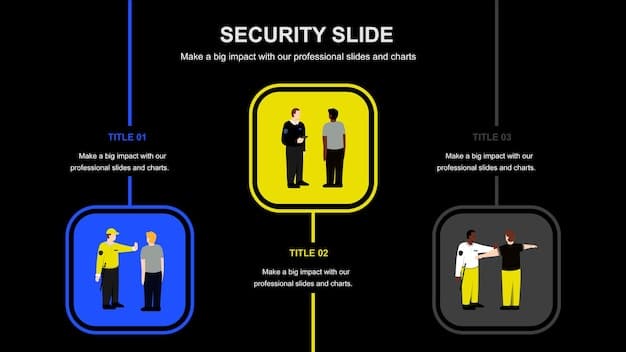Government Shutdown January 2026: Potential Consequences for the US

A government shutdown in January 2026 could halt non-essential federal services, impact the economy through reduced consumer spending and delayed payments, and disrupt various sectors, including national parks, federal agencies, and international relations.
The possibility of a **government shutdown in January 2026** looms, sparking concerns across the United States. Understanding the potential ramifications of such an event is critical for citizens, businesses, and policymakers alike. This article delves into the possible consequences, exploring how it could affect various aspects of American life.
What Happens During a Government Shutdown?
A government shutdown occurs when Congress fails to pass appropriation bills or a continuing resolution to fund federal government operations. This leads to a temporary closure of non-essential federal agencies and the furlough of non-essential federal employees. Understanding the mechanics is crucial to grasping the potential fallout.
Essential vs. Non-Essential Services
During a shutdown, essential services, such as national security, law enforcement, and emergency medical care, continue to operate. Non-essential services, however, are suspended, impacting a wide range of government functions.
The Role of Congress and the President
The responsibility to avoid a shutdown rests on Congress, which must pass and the President must sign appropriation bills. Political disagreements or delays in the legislative process can lead to a shutdown.
- Funding Gaps: Shutdowns arise due to disagreements over federal budget allocations.
- Political Gridlock: Partisan divisions can stall the passage of necessary funding bills.
- Continuing Resolutions: Temporary funding extensions are sometimes used, but they can also expire.
In essence, a government shutdown is a tangible manifestation of political impasse, directly impacting the operational capacity of numerous federal entities.

Economic Consequences of a January 2026 Shutdown
The economic implications of a government shutdown can be far-reaching, potentially affecting consumer spending, business activity, and overall economic growth. Analyzing past shutdowns offers insight into what might unfold in January 2026.
Impact on Federal Employees and Contractors
Furloughed federal employees face temporary unemployment, while government contractors may experience project delays or cancellations. This can lead to reduced income and decreased consumer spending.
Effects on Consumer Spending and Confidence
Uncertainty surrounding a shutdown can dampen consumer confidence, leading to reduced spending on non-essential items and services. This can negatively impact businesses, particularly in sectors reliant on discretionary spending.
- Reduced Tourism: National park closures affect tourism and related revenue.
- Delayed Payments: Businesses awaiting government payments may face cash flow issues.
- Market Volatility: Financial markets can react negatively to shutdown uncertainty.
Therefore, the anticipation and reality of a government shutdown can significantly undermine economic stability and confidence across various sectors.
Disruptions to Federal Agencies and Services
A government shutdown can cause significant disruptions to the operations of federal agencies, affecting services ranging from passport processing to food safety inspections. Understanding these disruptions is crucial for planning and mitigation.
Delays in Passport and Visa Processing
Passport and visa processing can be significantly delayed during a shutdown, affecting international travel and commerce. This can impact tourism, business travel, and immigration processes.
Impact on National Parks and Museums
National parks and museums often close during shutdowns, limiting access to recreational and cultural sites. This affects tourism, local economies, and public access to national treasures.
- Environmental Monitoring: Environmental protection and monitoring activities may be curtailed.
- Research Delays: Scientific research projects can face delays and funding disruptions.
- Healthcare Access: Certain healthcare services provided by federal agencies may be limited.
In short, the shutdown of federal agencies not only hampers daily operations but also has significant long-term consequences for various public services.

Social and Human Consequences
Beyond the economic and operational impacts, a government shutdown can have profound social and human consequences, affecting vulnerable populations and public morale. Addressing these impacts requires careful planning and response.
Impact on Food Assistance Programs
Food assistance programs, such as SNAP (Supplemental Nutrition Assistance Program), could face disruptions during a prolonged shutdown, affecting low-income individuals and families. This can lead to food insecurity and increased hardship.
Effects on Public Health and Safety
Reductions in public health services and safety inspections can pose risks to public health and safety. This includes potential delays in disease monitoring, food safety inspections, and emergency response capabilities.
- Veterans’ Services: Some services for veterans may be curtailed or delayed.
- Housing Assistance: Access to housing assistance programs could be affected.
- Social Security and Medicare: While Social Security and Medicare payments typically continue, administrative functions may be affected.
Therefore, the shutdown’s impact reaches into the daily lives and basic needs of many citizens, particularly those who rely on government assistance.
The Potential Political Fallout
A government shutdown invariably has political ramifications, influencing public opinion, electoral prospects, and the dynamics between political parties. Examining past instances can provide valuable context.
Blame Game and Public Perception
Shutdowns often lead to a “blame game” between political parties, with each side attempting to shift responsibility for the disruption. Public perception of each party can be significantly affected.
Impact on Presidential Approval Ratings
The President’s approval ratings can be affected by a shutdown, depending on how the administration is perceived to have handled the situation. Strong leadership or perceived inaction can sway public opinion.
- Electoral Consequences: Shutdowns can influence voter behavior in subsequent elections.
- Party Unity: Internal divisions within parties may be exacerbated during shutdown negotiations.
- Legislative Agenda: The shutdown can derail or delay other legislative priorities.
In essence, a government shutdown is not only a policy crisis but also a political theater, with significant implications for the standing of political actors.
Preparing for a January 2026 Shutdown
Given the potential for a government shutdown in January 2026, individuals, businesses, and government agencies should take proactive steps to prepare. Mitigation strategies can help minimize the negative impacts.
Personal Financial Planning
Individuals should assess their financial situation and develop a contingency plan for potential income disruptions. This includes saving emergency funds, reducing discretionary spending, and exploring alternative income sources.
Business Contingency Plans
Businesses should review their contracts, assess potential risks, and develop strategies for managing cash flow and supply chain disruptions. This includes identifying alternative suppliers and communicating with customers and stakeholders.
- Government Agency Preparedness: Agencies should update their shutdown plans and communicate essential information to employees and the public.
- Community Support: Local communities can organize support networks to assist those affected by the shutdown.
- Staying Informed: Staying informed about the status of budget negotiations and potential shutdown scenarios is crucial.
Therefore, preparedness is key to weathering the potential storm of a government shutdown, both on a personal and organizational level.
| Key Point | Brief Description |
|---|---|
| ⚠️ Service Disruptions | Federal agencies may halt non-essential services such as passport processing. |
| 💸 Economic Impact | Reduced consumer spending and delayed government payments may affect the wider economy. |
| 🏛️ Political Fallout | Shutdowns frequently lead to blame games and shifts in public perception. |
| 🛡️ Public Health Risks | Reduced monitoring and inspections could lead to risks in public health and safety. |
Frequently Asked Questions
A government shutdown is triggered when Congress fails to pass, and the President fails to sign, appropriation bills or continuing resolutions to fund the federal government, causing a temporary lapse in funding for non-essential operations.
Federal employees, particularly those deemed non-essential, are directly affected through furloughs. Businesses that rely on government contracts or payments, and citizens needing federal services (like passports) are also impacted.
Yes, Social Security and Medicare payments typically continue during a government shutdown because they are considered mandatory spending. However, administrative functions of these agencies may face delays or disruptions.
Assess your finances, create an emergency fund, and reduce discretionary spending. Explore alternative income sources and review your budget to identify potential cost-saving measures to prepare for possible income disruptions.
Reliable updates can be found through official government websites, reputable news organizations like the Associated Press, Reuters, and major news networks. Also, follow statements from congressional leaders and the White House.
Conclusion
The prospect of a **government shutdown in January 2026** carries significant potential consequences for the economy, federal services, and the lives of everyday Americans. Understanding these potential impacts and taking proactive steps to prepare is crucial for individuals, businesses, and policymakers alike. By staying informed and planning ahead, we can mitigate the disruptions and navigate the challenges that a shutdown may present.





